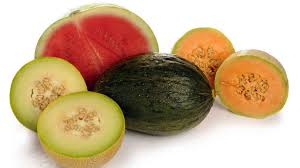A ripe, juicy cantaloupe or honeydew melon fresh from the vine is one of the sweetest tastes of summer. And a chilled slice of red or pink watermelon, with or without seeds to spit, is a warm-weather icon.
Cantaloupe, casaba, crenshaw, honeydew and Persian melons are all muskmelons (Cucumismelo). Watermelons (Citrulluslanatis or C. vulgaris) come from a different family, yet all these fruits have much in common. They all have high water and sugar content and thrive in summer heat.
To be successful with melons in Napa, where hot afternoons are often preceded by cool, foggy mornings, choose early- or short-season varieties that do not require uninterrupted sunshine and warmth. Muskmelon types that have proven successful in our area and are recommended by University of California Cooperative Extension include ‘Ambrosia Hybrid', ‘Burpee Hybrid', ‘Fruit Punch Hybrid', ‘Haogen', ‘Harper Hybrid', ‘Honeyshaw', ‘Jenny Lind', ‘Limelight', ‘Ogden', ‘Pineapple Hybrid', ‘Samson', ‘Sweet 'n Early Hybrid' and ‘Venus Hybrid'.
For the last two years, I have grown a cantaloupe type from Italy that has become my favorite:‘Melon RetatoDegliOrtolani'. Weighing three to four pounds, these melons have surface netting and a lush, sweet flesh. According to the seed packet, this is the proper melon to eat with Parma ham, although I find it delicious on its own. You can tell when one of these melons is perfectly ripe because the stem just falls off. No guessing. Purchase seeds from www.growitalian.com.
Watermelons require more heat than muskmelons. Grow early, icebox-sized types such as ‘New Hampshire Midget' to assure ripening before the end of the season. If you plant from seed, you will have access to a rainbow of colors.
Many muskmelons weigh in at a manageable three to four pounds, but watermelon can weigh up to 30 pounds. If you choose to go big, you may need a dedicated refrigerator for your harvest.
Whichever melons you choose to plant, prepare your beds or hills well. Melons are heavy feeders, needing plenty of nutrients, water and space. Trellising can help you optimize the area that you have, but be prepared to provide support for heavy melons as they swell. Old stockings or tights work well.
The University of California publication “Growing Melons in Napa County” has this to say: “Double-dig the area you will plant to melons. Before planting, work 5-10-10 fertilizer, or equivalent, into the soil at the rate of 3 pounds per 100 square feet. Bury a second application of fertilizer in a furrow about a foot away from the stem when runners are about a foot long. A third application can be made after the first melons set. Promote early flowering and fruit set by planting transplants. You can start your seed in pots four to six weeks before setting out into the field. Melon seeds germinate best at soil temperature above 75°F. Warm the soil before planting seeds by covering the prepared ground with clear plastic film. Melons are planted mid-May to mid-June on 6-by 6-foot spacing.
“Vines require plenty of water when growing vigorously, but hold back on water after fruits reach baseball size. Melons are deep rooted. Be sure to soak the soil to four feet deep. Weekly watering is normal for Napa County conditions. Excessive irrigation promotes root rot. It is normal for melon leaves to wilt in late afternoon during hot weather, but they should recover by morning. If not, they require a deep irrigation. Keep weeds out of melons until the vines shade the soil.”
More growing tips, including information on preventing pests and diseases, can be found in the publication “Growing Melons in Napa County” by Dean Donaldson. (http://ucanr.org/sites/ucmgnapa/files/81949.pdf)
How many muskmelons or watermelons should you plant? The size of your garden will generally be your limiting factor, but the California Master Gardener Tip Sheet (http://camastergardeners.ucanr.edu/files/28365.pdf) suggests five to ten hills of muskmelon or six watermelon plants for a family of four.
Whether you grow or purchase your melons, be sure to wash thoroughly in cool water before cutting them. The University of California recommends brushing off the loose dirt, washing well, rinsing in cool water and then sanitizing the exterior of the melon with a light chlorine solution. Seriously. You don't know where that melon has been.
Tomato Plant Sale: Napa County Master Gardeners will hold their second annual “Tomato Plant Sale and Education Day” on Saturday, April 19, in the South Oxbow parking lot on First Street in Napa. The sale will be held from 9:00 a.m. until sold out. All the seedlings have been started from seed and grown by Napa County Master Gardeners. At least 50 varieties of heirloom and hybrid tomato plants will be available. Master Gardeners will staff information tables on tomato support structures, common tomato pests and diseases, composting, good bug/bad bug displays and a mobile help desk. For a list of available tomato varieties, visit http://ucanr.org/ucmgnapa or call the Help Desk (hours below).
Master Gardeners are volunteers who help the University of California reach the gardening public with home gardening information. Napa County Master Gardeners ( http://ucanr.org/ucmgnapa/) are available to answer gardening questions in person or by phone, Monday, Wednesday and Friday, 9 a.m. to Noon, at the U. C. Cooperative Extension office, 1710 Soscol Avenue, Suite 4, Napa, 707-253-4143, or from outside City of Napa toll-free at 877-279-3065. Or e-mail your garden questions by following the guidelines on our web site. Click on Napa, then on Have Garden Questions? Find us on Facebook under UC Master Gardeners of Napa County.
Napa County Master Gardeners welcome the public to visit their demonstration garden at Connolly Ranch on Thursdays, from 10:00 a.m. until noon, except the last Thursday of the month. Connolly Ranch is at 3141 Browns Valley Road at Thompson Avenue in Napa. Enter on Thompson Avenue.
